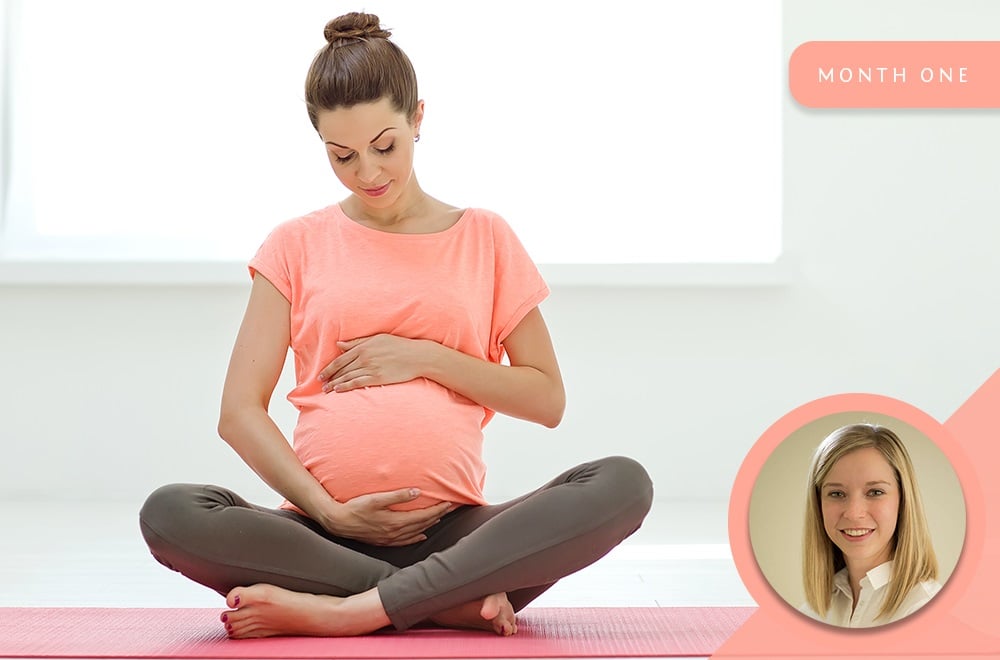
13 Jul Pregnancy: Month 1: A Physiotherapist’s Professional Opinion
The first month of your pregnancy is generally uneventful for most expecting mothers. Some women only know that they are pregnant once they have missed their period or after they have done a pregnancy test that is positive. For most women, the hormone hCG, which is what we use to detect that you are pregnant during a pregnancy test, is only present in high enough levels to produce a positive result during your fourth to fifth week of your pregnancy. During this month, the fetus is a mere 0.1mm to 0.2mm in size.
This month various hormone levels will start to change. The hormones responsible for physical changes are mainly oestrogen, progesterone and relaxin. The initial changes in these hormone levels can cause symptoms such as breast tenderness, fatigue, as well as new food sensitivities.
So, let’s break down the role of these three hormones and the effect they have on your body, as it is important to know how they work and the effect they will have on your body every month of your pregnancy.
First up: estrogen. This hormone is initially produced by your ovaries after which production is taken over by the placenta. It helps your uterus grow, maintains the uterus lining and creates a lovely cushion layer for your baby nest. Estrogen gets the ball rolling in the growth of your breast tissue. This hormone is to thank for turning your breasts into little milk factories. Estrogen increases the blood flow to many parts of your body such as your skin, glands and mucous membranes.
Progesterone is next in line. Equally as important, progesterone takes over the role of further developing your breast tissue. It also relaxes the smooth muscles throughout your body. Your uterus, stomach lining, skin and all your blood vessels contain smooth muscles.
Progesterone teams up another hormone called relaxin to soften cartilage and ligaments. Both of these structures are present between every joint in your body. A joint is made up of the connection between two bones. The softening of the cartilage and ligaments is very important to prepare your body for the birth of the baby, as it gives a joint the ability to move and stretch more than it normally does.
Exercise is an extremely important aspect of your well-being to be addressed throughout your pregnancy. Apart from cardiovascular exercise, it is very important to incorporate exercises that will support and strengthen your pelvic floor, diaphragm as well as your back muscles. This will prevent you from having many of the physical complications that could arise during and after pregnancy. Strengthening these muscles will make the birth process a more comfortable process. Strengthening your pelvic floor muscles should be done from day one. These exercises are known as Kegels.
EXERCISE OF THE MONTH: KEGELS
- The key to doing your pelvic floor muscle exercises is to do them frequently and for short periods throughout the day.
- The easiest way to figure out how to activate your pelvic floor muscles is by stopping a stream of urine mid-stream when urinating. Once you think you have figured out how to activate these muscles, do not repeatedly squeeze off a stream of urine. This could lead to urinary tract infections and more complications.
- Tighten the muscles for three to five seconds, relaxing for the same amount of time. Relaxing these muscles are as important as tightening these muscles. Remember to breathe while holding the contraction.
- Work your way up to holding the contraction for 10 seconds.
- Repeat for five repetitions and repeat sets frequently throughout the day.



Pingback:Pregnancy: Month 5: A Physiotherapist's Professional Opinion - Faithful to Nature Natural and Organic Blog
Posted at 10:27h, 13 July[…] the hormones have been working hard at loosening the ligaments and cartilage in your joints, the effects of this […]
Pingback:Pregnancy: Month 8: A Physiotherapist's Professional Opinion - Faithful to Nature Natural and Organic Blog
Posted at 10:54h, 13 July[…] continue to pick up weight weekly. The rapidly growing fetus now starts to push against your rib cage and organs. This could lead to […]
Pingback:Finding out | Month 1 - Faithful to Nature Natural and Organic Blog
Posted at 19:31h, 13 September[…] Pregnancy: Month 1: A Physiotherapist’s Professional Opinion […]
Pingback:Month 1: Finding Out I Was Pregnant - Faithful to Nature Natural and Organic Blog
Posted at 13:11h, 05 November[…] Pregnancy: Month 1: A Physiotherapist’s Professional Opinion […]